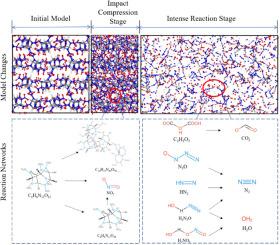ε-CL-20微尺度冲击响应特性:耦合力场的多尺度模拟研究
IF 6.2
2区 工程技术
Q2 ENERGY & FUELS
引用次数: 0
摘要
探索临界起爆条件的微观机制是含能材料激波研究中的一个具有挑战性的课题。通过耦合NNP-SHOCK力场和ReaxFF-lg力场,在8.0 ~ 10.0 km/s的速度范围内对己硝基己氮化硅(ε-CL-20)进行了多尺度冲击模拟。以峰值压力为阶段划分指标,将冲击起爆过程定量划分为冲击压缩和剧烈反应两个阶段。在众多的ε-CL-20分解产物中,CO2含量是反映ε-CL-20初始反应过程的关键指标,而不是初始产物NO2。当冲击波速度低于CL-20的临界起爆速度(9.1 km/s)时,CO₂量变化与单胞压力变化的相关性特别高。相应的,在临界爆速作用下,计算得到CL-20的临界分解速率为9.451 ps-1。绘制了ε-CL-20及其典型终产物(CO2、H2O、N2)的反应网络图,明确了ε-CL-20的初始转化途径,确定了CO2、H2O、N2化学反应之间的内在关系。本文章由计算机程序翻译,如有差异,请以英文原文为准。

Microscale impact response characteristics of ε-CL-20: A multiscale simulation study with coupled force fields
Exploring the microscopic mechanism of critical initiation conditions is a challenging task in shock research on energetic materials. Herein, a multiscale impact simulation of hexanitrohexaazaisowurtzitane (ε-CL-20) was conducted within a velocity range of 8.0∼10.0 km/s by coupling the NNP-SHOCK force field with the ReaxFF-lg force field. Using peak pressure as a stage division indicator, the impact initiation process was quantitatively divided into two stages: impact compression and intense reaction. Among the large variety of ε-CL-20 decomposition products, CO2 content was identified as a key metric to reflect the initial reaction process of ε-CL-20, rather than the initial product NO2. The correlation between the change in CO₂ quantity and the change in unit cell pressure is particularly high when the shock wave velocity is below the critical shock initiation velocity (9.1 km/s) of CL-20. Correspondingly, the calculated critical decomposition rate of CL-20 reaches 9.451 ps-1 when subjected to a critical detonation velocity. In addition, reaction network diagrams of ε-CL-20 and its typical final products (CO2, H2O, and N2) were drawn to clarify the initial transformation pathways of ε-CL-20 and to determine the intrinsic relationships among the chemical reactions of CO2, H2O, and N2.
求助全文
通过发布文献求助,成功后即可免费获取论文全文。
去求助
来源期刊

Combustion and Flame
工程技术-工程:化工
CiteScore
9.50
自引率
20.50%
发文量
631
审稿时长
3.8 months
期刊介绍:
The mission of the journal is to publish high quality work from experimental, theoretical, and computational investigations on the fundamentals of combustion phenomena and closely allied matters. While submissions in all pertinent areas are welcomed, past and recent focus of the journal has been on:
Development and validation of reaction kinetics, reduction of reaction mechanisms and modeling of combustion systems, including:
Conventional, alternative and surrogate fuels;
Pollutants;
Particulate and aerosol formation and abatement;
Heterogeneous processes.
Experimental, theoretical, and computational studies of laminar and turbulent combustion phenomena, including:
Premixed and non-premixed flames;
Ignition and extinction phenomena;
Flame propagation;
Flame structure;
Instabilities and swirl;
Flame spread;
Multi-phase reactants.
Advances in diagnostic and computational methods in combustion, including:
Measurement and simulation of scalar and vector properties;
Novel techniques;
State-of-the art applications.
Fundamental investigations of combustion technologies and systems, including:
Internal combustion engines;
Gas turbines;
Small- and large-scale stationary combustion and power generation;
Catalytic combustion;
Combustion synthesis;
Combustion under extreme conditions;
New concepts.
 求助内容:
求助内容: 应助结果提醒方式:
应助结果提醒方式:


